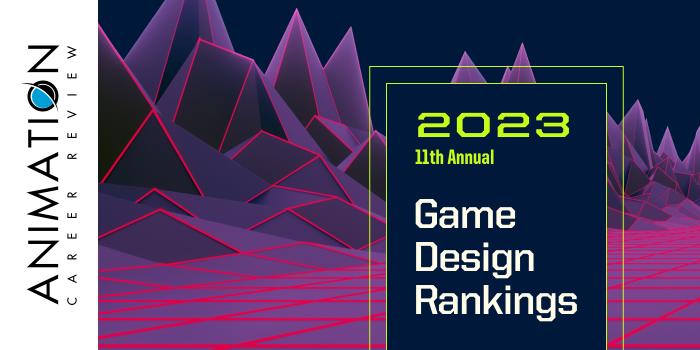
Did You Know? Clemson Digital Production Arts has recent graduates in our alumni network working at Pixar Animation, Epic Games, Blur Studios, Ubisoft, DreamWorks Animation, and other top studios. Learn More.

| Ranking | School | State |
|---|---|---|
| 1 | University of Central Florida | Florida |
| 2 | Full Sail University | Florida |
| 3 | Savannah College of Art and Design | Georgia |
| 4 | Georgia Institute of Technology | Georgia |
| 5 | Ringling College of Art and Design | Florida |
| 6 | North Carolina State University | North Carolina |
| 7 | University of Florida | Florida |
| 8 | Clemson University | South Carolina |
| 9 | University of North Carolina at Charlotte | North Carolina |
| 10 | Georgia State University | Georgia |
| 11 | Louisiana State University | Louisiana |
| 12 | University of South Carolina | South Carolina |
| 13 | The Digital Animation & Visual Effects School | Florida |
| 14 | Kennesaw State University | Georgia |
| 15 | East Tennessee State University | Tennessee |
| 16 | University of Alabama in Huntsville | Alabama |
| 17 | Loyola University New Orleans | Louisiana |
| 18 | Eastern Kentucky University | Kentucky |
| 19 | University of Louisiana at Lafayette | Louisiana |
| 20 | William Peace University | North Carolina |
Our 2023 rankings of the top 20 game design schools in the South. We define the South as Florida, Georgia, Alabama, Louisiana, North Carolina, South Carolina, Kentucky, West Virginia, Tennessee, Mississippi, Arkansas. For an explanation of our ranking criteria, click here.

The College of Sciences at University of Central Florida (UCF) houses Nicholson School of Communication and Media (NSCM), which has a Digital Media BA Program with a Game Design Track, an Interactive Entertainment MS, a Digital Media MA, and a Digital Media Minor. Also part of Florida Interactive Academy (FIEA), the MS has Specializations in Programming, Animation, Technical Art, Level Design, 3D Modeling, and Project Management. Specializations are sub-tracks within the FIEA Production/Design, Art, and Programming Tracks.
Students in all FIEA and NSCM Programs at University of Central Florida have access to state-of-the-art production facilities, such as the 3,300 square feet MOCAP studio, where they have the opportunity to develop their own games and interactive projects from start to finish. Internships and career development resources are also available, and many FIEA students publish their games through avenues such as Xbox or Steam, resulting in their first published title.
Graduates of the UCF Games/Interactive Media and FIEA Programs have been hired by more than 300 companies. Examples include Epic Games, Walt Disney Imagineering, Zynga, Unity Technologies, Lockheed Martin, Marvel, Sony, Gameloft, Blizzard Entertainment, Nintendo, Cartoon Network, Electronic Arts (EA), Google, Industrial Light & Magic (ILM), and Blur Studio.
University of Central Florida opened in 1968 as Florida Technological University. On the first day of classes, the school had less than 2,000 students. Today, UCF serves around 70,400 students, making it the largest university by enrollment in the state of Florida, and one of the nation’s largest universities. The school offers 535 degree programs across 13 colleges. University of Central Florida is accredited by the Southern Association of Colleges and Schools Commission on Colleges (SACSCOC).

Full Sail University is home to The Gaming School which houses production studios and classrooms that look and feel like major production studios. Degree options here include the Game Design BS and MS and BS degrees in Game Art, Game Development, Simulation & Visualization, and Game Business & Esports. Undergraduate Certificates in 3-D Arts, Game Design, and Game Business & Esports are also available. The Simulation & Visualization BS is offered on campus and all other programs are offered both on campus and online.
In addition to gaining production experience in a real-world studio environment on the Full Sail University campus, gaming students have opportunities to work off campus at local and national studios through the internship program. Courses in The Gaming School are also immersive. Course examples across all programs include Motion Capture, Game Mechanics, Game Production Tools, Engine Development, Artificial Intelligence (AI), and Data Visualization & Modeling. Students will master all roles in the production pipeline, video game development for computers, networks and consoles, test simulation, game effects, narrative design, and animation.
Full Sail University’s Career Development Department provides 24/7 access to job opportunities, along with workshops and presentations that cover branding, networking, research strategies, and interviewing techniques. The department also coordinates local hiring events and events in other major markets such as Los Angeles and New York.
Full Sail University graduates have worked on many popular games, films, and ad campaigns. Games include Call of Duty: Modern Warfare II, Overwatch 2, Horizon Forbidden West, Apex Legends, Destiny 2, and Fortnite. More than 200 graduates from Games, Art & Design, Music & Recording, Business, and Media & Communications areas were credited on over 25 projects nominated in 21 categories at The 2022 Game Awards.
Graduates from Game Design, Film, and Entertainment Business also contributed to winners in categories including Best Adaptation (Arcane: League of Legends), Best Esports Game (Valorant), Best VR/AR (Moss: Book II), Best Fighting (MultiVersus), and Games for Impact (As Dusk Falls).
Companies and studios that have hired Full Sail University graduates include Disney, Rockstar Games, Blizzard Entertainment, Industrial Light & Magic (ILM), Nickelodeon, Bunim Murray, Pixar, MTV, ESPN, Universal Studios, Miramax, DreamWorks, and HBO.
Full Sail University offers graduate certificates and programs at all degree levels in the Arts, Entertainment, Media, and Technology. The school, which opened in 1979 in Dayton, Ohio, is located just 35 minutes from downtown Orlando and Universal Studios. Serving approximately 21,000 students, Full Sail is accredited by the Accrediting Commission of Career Schools and Colleges (ACCSC).

The School of Digital Media at Savannah College of Art and Design (SCAD) has a number of pathways to study game design. Undergraduate options include a Digital Media BA with Game Development and Interactive Design Tracks, an Interactive Design and Game Development (IDGD) BFA, and Minors in Concept Design for Animation and Games, Game UX, Interactive Design and Game Development, Concept Art for Games, and Mobile and Interactive Design. At the graduate level, SCAD’s School of Digital Media has MA and MFA degrees in IDGD. Programs are offered at the Atlanta and Savannah campuses, as well online via SCADnow.
The School of Digital Media at SCAD provides opportunities for game design students to gain hands-on experience through internships with local and national studios. Students will also work individually and in teams to complete projects while utilizing state-of-the-art customized facilities at Montgomery Hall—a 130,000 square feet space consisting of studio classrooms, more than 800 computers, stop-motion sets, a green-screen stage, motion-capture technology, and AR/VR resources. The SCAD Digital Media Center in Atlanta provides an in-house theater, green screen lab, and a real-world studio environment.
Each quarter, students have the opportunity to interview and present their portfolios to professionals in the industry. Past visitors have been affiliated with studios such as Electronic Arts (EA), Zynga, and Activision Blizzard. Graduates of the IDGD Programs at Savannah College of Art and Design are routinely hired by these and other studios such as Epic Games, Firaxis Games, and Sucker Punch Productions.
Savannah College of Art and Design opened in the renovated Savannah Volunteer Guards Armory in September 1979. The school launched with just one classroom, an administration building, and 71 students. Today, SCAD serves more than 15,000 students across campuses in Atlanta and Savannah, Georgia, and Lacoste, France. With more than 100 degree programs and over 75 minors and certificate programs, Savannah College of Art and Design has more degree programs and specializations than any other art and design college in the U.S.
Savannah College of Art and Design is accredited by the Southern Association of Colleges and Schools Commission on Colleges (SACSCOC), the Council for Interior Design Accreditation (CIDA), and the National Architecture Accrediting Board (NAAB).

Georgia Institute of Technology (Georgia Tech) provides a number of pathways to study game design across several colleges and schools. The College of Computing and the School of Literature, Media, and Communication in the Ivan Allen College of Liberal Arts offer a Computational Media BS (BSCM), MS and PhD degrees in Digital Media and a Computing & Media Minor. A dual Computer Science BS/MS is available as well as a unique undergraduate Certificate in Scenarios, Models, and Military Games. This program explores the use of scenarios, models, and gaming in the analysis of national security issues. Course examples include Modeling, Simulation, and Military gaming, Simulation and Military Gaming, and Scenario Writing and Pathgaming.
The BSCM Program at Georgia Tech launched in 2004 with just one student. Today, the program serves more than 300 students, making it one of Georgia Tech’s fastest growing programs. The BSCM Program provides the opportunity to focus in areas such as Games, Interaction, and Narrative. Course examples include Game Studio, Game Design as a Cultural Practice, Game AI, Video Game Design and Programming, Digital Video Special Effects, Constructing the Moving Image, Computer Animation, and Principles and Applications of Computer Audio.
Georgia Tech’s Computing & Media Minor requires 19 credit hours of study, with elective course options such as Video Game Design and Programming, Digital Video Special Effects, and Information Visualization. Just a few required courses include Media Device Architectures, Objects and Design, Computer Graphics, and Computer Organization and Programming.
Across all graduate level programs, courses may include Special Topics in Game Design, Human-Computer Interaction (HCI), Interactive Fiction, Experimental Media, Principles of Interactive Design, Pro-Seminar, and Project Studio. Graduate students will also complete an 8-10 week, full-time non-credit internship and a Thesis Project.
All students have access to the GVU Center Game Studio at Georgia Tech, the Institute for People and Technology (IPaT), and international campuses in the world’s largest games industry—China.
Graduates of the Digital and Computational Media Programs at Georgia Institute of Technology have established successful careers in fields such as Game Design and Development, Interactive Design and Game Simulation, Animation, Special Effects, AI and Robotics, Visual Effects (VFX) and 3D Modeling.
Georgia Institute of Technology was established in 1885. When it opened, the school had just 129 students enrolled in one degree program—the Mechanical Engineering BS. Today, Georgia Tech serves more than 40,000 students enrolled in more than 180 degree programs and minors across six distinct colleges and 28 schools. Georgia Institute of Technology is accredited by the Southern Association of Colleges and Schools Commission on Colleges (SACSCOC).

Ringling College of Art and Design (RCAD) has a Game Art BFA Program that attracts recruiters from major studios such as Blizzard Entertainment, Epic Games, and Riot Games. The program explores topics such as environmental design, professional practices, methods and technologies, and concept and creative problem-solving. Students also work on projects in teams to develop collaboration and communication skills.
Following the studio model of teaching, which emphasizes learning by doing, the Game Art BFA at Ringling College of Art and Design also highlights visiting artists, industry internships, and other experiences that provide the opportunity to work on real projects with local businesses and studios.
The RCAD Game Art BFA requires 48 credit hours in the major. This accounts for 40% of the coursework. Course examples for the program include 3D for Games I-IV, Game Design I-II, Programming for Artists, and Visual Development for Games. BFA students will also take four courses leading to the development of a Game Thesis Project.
Graduates of the Game Art BFA Program at Ringling College of Art and Design have been hired at Blizzard Entertainment, Rockstar Games, 343 Industries, Bungie, Bethesda Game Studios, and Naughty Dog, among others.
Ringling College of Art and Design is a private, not-for-profit college that has been in existence for more than 90 years. Co-founded by circus baron John Ringling, RCAD serves more than 1,600 students enrolled in eleven majors leading to a BFA degree, two majors leading to a BA degree, and minor options in 10 areas. Ringling College of Art and Design is accredited by the National Association of Schools of Art and Design (NASAD) and the Southern Association of Colleges and Schools Commission on Colleges (SACSCOC).

North Carolina State University (NC State) is home to the College of Engineering, which houses the Department of Computer Science (CSC). Within the Department is the CSC BS Program with a Game Development Track, and an Accelerated Bachelor’s/Master’s (ABM) degree in CSC. The ABM allows BS students to complete the CSC MS Program in within 12 months of completing their BS (non-thesis) or within 18 months for the thesis-based MS.
The CSC BS program begins with computing, mathematics, chemistry, physics, and humanities. Next, students will dive into coursework that explores programming languages, computer architectures, software engineering, data structures, and teaming and communication, among other areas.
Once core requirements are complete, students may advance to the Game Development Concentration, which consists of 21 credit hours of games-focused courses and electives. Examples include Foundations of Interactive Game Design, Computer Graphics, Game Engine Foundations, Computational Visual Narrative, Building Game AI, Game Studies, Special Topics in Film Styles and Genres, Computer Models of Interactive Narrative, and Fantasy.
All CSC BS students must complete a team project in Senior Design. Projects are supported by the Senior Design Center and industrial sponsors, so student teams will gain experience working industry representatives.
Students in all NC State CSC programs have access to The Digital Games Research center (DGRc). Launched in May 2007, The DGRc engages in education and research in games and games technologies. In a collaborative environment, students can work on projects with game developers and games studio teams that focus on everything from mobile games to artificial intelligence (AI). Thanks to partnerships and licensing agreements with engine providers and game studios, NC State graduates are often hired by local game companies.
Other DGRc highlights include access to the new Games and Visual Narrative Suite, the Visual Narrative Initiative (VNI)— a research cluster established in 2015, and participation in the Game Developers Conference and Games and Visual Narratives Showcase.
Graduates of the CSC Programs at North Carolina State University are prepares to pursue positions at high-tech companies, game design studios, and entertainment companies, among others.
North Carolina State University employs more than 9,000 faculty and staff members serving 36,000+ students, making it the largest university in the University of North Carolina System. Established in 1887 as a land-grant institution focusing in agriculture and engineering, NC State offers more than 300 degree programs across 11 colleges, 68 departments, and The Graduate School. North Carolina State University is accredited by the Southern Association of Colleges and Schools Commission on Colleges (SACSCOC).

Established in 1925, the College of the Arts at University of Florida (UF) houses the Digital Worlds Institute, home to the Digital Arts & Sciences (DAS) Program. Degree options for game designers include the DAS BA (BADAS), the DAS Minor, and the DAS Masters (MiDAS), the BADAS is offered on campus and fully online through UF Online.
Digital Worlds Institute highlights include the DAS Mentorship Program, guest lecturers, access to LUMA at Digital World Studios, Portfolio Open House events, and participation in the internship program. In addition, all UF Digital Worlds Programs are interdisciplinary and combine arts, engineering, communications, and science. Course examples across pathways include Creating Mobile Games, 3D Animation Techniques, Game Content Creation, Game Systems Development, Game Design and Production, Digital Storytelling, Game Development, and Interaction & Usability. An optional internship is also part of the program.
The BADAS Program requires 120 credit hours of study and successful completion of the final DAS project. The UF MiDAS Program explores game engines and development, software and hardware integration, design and interactivity, emerging technologies such as AR/VR, and proposals, project management, and production pipelines. The MiDAS program is offered in an accelerated format, so it takes just one year to complete.
Graduates of the BADAS and MiDAS Programs at University of Florida are Game Designers, Level Designers, Game Artists, Character Modelers, Visual Effects (VFX) Artists, Software Engineers, Technical Animators, Digital Storytellers, Motion Graphics Animators, UI/UX Designers, Production Coordinators, Entrepreneurs, and Freelance Designers. Program alumni have been hired at major companies and studios such as Microsoft and DreamWorks.
University of Florida was founded in 1858 as Gainesville Academy. When it opened, the Academy has just a few students. Today, UF serves approximately 61,110 students enrolled in more than 300 undergraduate and graduate programs across 16 colleges and schools. The University of Florida is accredited by the Southern Association of Colleges and Schools Commission on Colleges (SACSCOC).

The College of Engineering, Computing and Applied Sciences at Clemson University is home to the School of Computing, which houses the Division of Visual Computing. Within the Division is the Digital Production Arts (DPA) Program. This interdisciplinary program collaborates with the Departments of Art and Performing Art, with a significant focus on advanced studios and visualization as a problem-solving tool.
Specific DPA options for game designers include the DPA MFA/MS (MFA DPA/MS DPA) and the DPA Minor. Offered since 2011, the DPA Minor focuses on Games, Visual Effects, and Computer Animation. The Computer Science (CS) BA/BS and a fast-track Computer Science Bachelor’s/Master’s (BS/MS) provide additional opportunities to study game design.
Course examples across programs include Game Theory, Studio Methods for Digital Production 2D Game Engine Construction, Algorithms and Techniques, Visual Foundations of Digital Production, 3D Game Programming: Artificial Intelligence (AI), Physical Modeling and Animation, Advanced 3D Modeling, and Audio Practicum.
Other Computer Science and DPA highlights include visits from representatives of major studios such as DreamWorks, internship opportunities, high-tech classrooms, state-of-the-art production studios and facilities, study abroad experiences, collaboration spaces and participation in the SIGGRAPH Conference. In addition, DPA MFA students have the option to study at the main campus in Clemson or at the Zucker Family Graduate Education Center (ZFGEC) in Charleston, South Carolina. MFA students can attend traditional face-to-face classes or via “real-time” streaming to and from the main campus. DPA MFA students are not required to travel between campuses.
Graduates of the DPA and Computer Science Programs at Clemson University are Game Designers, Animators, Game Programmers, Technical Directors, Software Engineers, 3D Graphics Programmers, Art Directors, and AR/VR designers, among others. Clemson DPA and CS alumni have secured positions with companies such as Google, Disney Animation, Electronic Arts (EA), Blur Studio, Sledgehammer Games, IBM, and CrowdStrike.
Clemson University began as Clemson Agricultural College in 1893. The school serves approximately 27,340 students enrolled in more than 200 degree programs and 90+ minors across seven colleges and a graduate school. Clemson University is accredited by the Southern Association of Colleges and Schools Commission on Colleges (SACSCOC).

University of North Carolina at Charlotte (UNC Charlotte) has several options for students seeking a computer science-based game design program. Programs are housed in the College of Computing and Informatics’ Department of Computer Science (CS) and include a Computer Science BS with an AI, Robotics, and Gaming Concentration, a Computer Science with an optional AI, Robotics, and Gaming Concentration, and Game Design and Development (GDD) Certificates at the undergraduate and graduate levels. Coursework for the certificate programs may be used towards the Computer Science BS or MS programs.
Course examples across programs include Game Engine Construction, Advanced Algorithms, Game Design and Development Studio, Advanced Game Design and Development, AI for Computer Games, Individual Study in AI, Robotics, and Gaming, Virtual and Augmented Reality, Applied Machine Learning, Computer Science, Audio Processing for Entertainment Computing, Real-Time Rendering Engines, and Computer Graphics.
The College of Arts and Architecture at UNC Charlotte has an additional option for designers seeking a digital media-based game design program. Housed in the College’s Department of Art and Art History, the Art BFA with a Digital Media Concentration requires advanced studio coursework, which allows students to craft a focus from electives such as Game Design and Graphics, Interactive Art and Design, Advanced 3D Modeling and Digital Fabrication, and 3D Modeling and Animation.
The Art BFA also requires successful completion of the Senior Experience. Totaling nine credit hours, the Experience includes Senior Seminar, Senior Thesis I: Creative Research, and Senior Thesis II: Advanced Creative Practice.
Graduates of the CS/Game Design Programs at University of North Carolina at Charlotte are prepared to pursue positions in fields such as games and entertainment, animation, computer science, art and design, programming, software development, multimedia, advertising, and education.
University of North Carolina at Charlotte is a public research university and the third largest school in the 16-campus University of North Carolina system. Founded in 1946, the school serves approximately 29,550 students enrolled in more than 200 undergraduate, graduate, and doctoral programs across nine colleges. University of North Carolina at Charlotte is accredited by the Southern Association of Colleges and Schools Commission on Colleges (SACSCOC).

Georgia State University (GSU) houses the College of Arts and Sciences, home to the Creative Media Industries Institute (CMII), which has several paths to study game design. Options include a Game Design BA, a Game Development BS, and a Bachelor of Interdisciplinary Studies (BIS) with a Concentration in Game Design and Development.
The BA combines the study of art with the development of software platforms for games. The BS explores coding, programming, and software design for students interested in game development or other areas such as app development, animation, and motion graphics. The BIS/Game Design and Development Program has two sequences: one designed for students who are interested in game development and the other for individuals interested in coding games.
Students in all GSU CMII programs have access to the Innovative Media Club, workshops, an advanced motion capture system, and the Georgia Game Developers Association. Students also have opportunities to collaborate with partners such as the Georgia Film Academy and they may participate in the weekly Playtest—an immersive, hourlong gathering that explores game concepts, mechanics, and experiences. Internship opportunities with potential studios such as KontrolFreek – Atlanta and Hi-Rez Studios, are also part of the program.
Graduates of the Georgia State University CMII are prepared to purse positions in Game Design and Development, Game Programming, Game Art, Game Writing, Game Animation, Multimedia, Software Design, Concept Art, Applications Development, Quality Assurance, and Level Design, and other areas fields that require game design and development skills.
Georgia State University was founded in 1913 as the Georgia Institute of Technology's "Evening School of Commerce." Today, GSU consists of six campuses, 12 colleges and schools, and more than 52,000 students from close to 130 nations and territories. GSU provides more than 250 degree programs in 100 fields of study at the school’s Downtown Atlanta Campus alone. The school offers the widest variety of academic programs in the entire state. Georgia State University is accredited by the Southern Association of Colleges and Schools Commission on Colleges (SACSCOC).

Louisiana State University (LSU) has a Digital Media Arts & Engineering (DMAET) Program, which has several options for game designers. At the undergraduate level students can enroll in the DMAET or Digital Media Arts & Engineering Minor in Art (DMART). The minor programs are a collaboration between seven campus units at LSU. This includes the School of Art, School of Music, Manship School of Mass Communication, and the Departments of Computer Science, English, and Electrical & Computer Engineering. Both minors complement any art, computer science, or engineering program.
Students in the both interdisciplinary, 21 credit hour programs can choose from a variety of electives to support their goals. Examples include Video Game Design, Video Game Prototyping, Interactive Computer Graphics, Scientific Information Visualization, Creative Coding, Virtual Space and Motion, Human-Computer Interaction (HCI), 3D Modeling, Digital Media Programming, Moving Image, Artificial Intelligence (AI), 3D Animation, Applied Interactive Graphics, Digital Arts I-IV, and Interface Design and Technology. Minor students must complete a Capstone Project to graduate.
At the graduate level, LSU’s Division of Computer Science & Engineering has a Master’s in Digital Media Arts & Engineering (MDMAE). Course examples for the program include Interactive Design, Rapid Prototyping & Innovation, Digital Media Production & Project Management, and Advanced Programming & Digital Art. Students in this program will use industry software tools such as Maya, Nuke, Unity, and Houdini, to create works.
Halfway through the LSU MDMAE program, students will complete a Digital Media Internship. During the final two semesters, students will work in teams to complete a Capstone Project. The MDMAE at LSU takes 22 months to complete, full-time.
Louisiana State University was founded in 1860 as the Louisiana State Seminary of Learning and Military Academy. The flagship institution of the Louisiana State University System, LSU serves more than 35,000 students enrolled in over 330 programs across 18 colleges, schools, and centers, and LSU Online. Louisiana State University is accredited by the Southern Association of Colleges and Schools Commission on Colleges (SACSCOC).

The College of Arts and Sciences at University of South Carolina (UofSC) houses the School of Visual Art and Design (SVAD), home to the Media Arts Program. Degree options here include the BA and MA in Media Arts. An 18 credit hour Media Arts Minor is also available.
The College of Engineering and Computing at UofSC is home to the Department of Computer Science and Engineering, which houses the BS, MS, and PhD degrees in Computer Science (CS) and Computer Engineering. Minor options in Applied Computing and Computer Science ae also available.
The SVAD BA and MA degree programs are multidisciplinary, so they appeal to students interested in game design, animation, and filmmaking, among other areas. Course examples across programs include New Media Advanced: Video Game Design, Digital Imaging, Moving Image Advanced: Animation, Narrative Production, Media Writing, Manga and Anime, Sound Design, and Media Management and Distribution.
SVAD classes are held in an 85,000-square-foot facility known as McMaster College. The facility was designed specifically for the learning and production in the visual arts. Other SVAD features include internship opportunities and the creation of a marketable final project and professional portfolio.
Graduates of the SVAD Media Arts Programs have been hired at companies and studios such as Blizzard Entertainment, Nickelodeon, Netflix, HBO Films, Marvel, IBM, CBS Television, lD Software, and Kodansha USA.
Students in the University of South Carolina CS Programs may add the Media Arts Minor or select three courses from CS electives and three from another major. Requirements across CS programs include Software Engineering, UNIX/Linux Fundamentals, Digital Logic Design, Computer Architecture, and Programming Languages Structures.
Computer Science and Computer Engineering students will complete an internship and create a professional portfolio of their work. University of South Carolina CS alumni work in areas such as game design and development, game programming, software design and development, and software engineering.
Established in 1801 as South Carolina College, University of South Carolina is one of the nation’s oldest public universities. Part of the eight-campus University of South Carolina System, UofSC provides more than 300 areas of study to a population of nearly 35,400 students. Programs are offered across 16 colleges and schools. University of South Carolina is accredited by the Southern Association of Colleges and Schools Commission on Colleges (SACSCOC).

The Digital Animation & Visual Effects School (DAVE School) has several award options: the 12-month Diploma, 18-month Diploma, the 32-month Bachelor’s, and the 36-month Bachelor’s. For game designer’s The DAVE School has a 12-month Diploma and a 32-month Bachelor’s degree in Game Production. DAVE students can earn the Diploma separately or as part of the 120 credit hour Bachelor’s degree program. Students in the Bachelor’s program will receive the Diploma credential after completing 60 credits.
The DAVE School also has a Virtual Production (VP) Diploma Program, which combines the curriculums of the Game Production and Visual Effects Production Diplomas. The VP Program takes 18 months to complete.
Across all production programs, students will explore areas such as game physics, world building, asset creation, concepts and terminology of game production, Unreal Engine, lighting and production techniques, emerging technologies, and Unreal for AR/VR. Course examples across programs include Advanced Asset Creation & Look Development, Emerging Real-Time Tech & Pipelines, Digital Modeling and Sculpting, Fundamentals of Computer Animation, and Real-Time Rendering & Emerging Technologies.
The programs at The Digital Animation & Visual Effects School emphasize collaboration, so students will complete a three-month residency in Orlando, Florida where they will work in teams to create games across the entire production pipeline. For the final project, DAVE students will complete an in-house game that will become a major component of their professional demo reel.
DAVE school graduates are Gameplay Animators, Pipeline Supervisors, Lighting Artists, Cinematic Animators, Compositors, Environment Artists, and Art Coordinators. DAVE School alumni (and instructors) have worked on productions and games such as Game of Thrones, Terminator Genisys, The Hobbit, Avengers: Age of Ultron, Call of Duty: Black Ops Cold, The Mandalorian, Walking Dead: Saints & Sinners, Rogue One: A Star Wars Story, Deadpool, Green Lantern, Captain America, Dumbo, Conan Exiles, Anthem, The Hunger Games, Jurassic World, Godzilla: King of the Monsters, and The Hobbit, among others.
The Digital Animation & Visual Effects (DAVE) School was founded in 2000. Located on the backlot of Universal Studios, Florida, The DAVE School is an academic unit of NUC University, which is accredited by the Middle States Commission on Higher Education (MCSHE). DAVE serves around 1,000 students enrolled in six programs leading to a Bachelor’s degree or Diploma.

The College of Computing and Software Engineering (CCSE) at Kennesaw State University (KSU) is home to the Department of Software Engineering and Game Design and Development (SWEGD). Programs in the Department are accredited by the Computing Accreditation Commission of ABET. For game designers, SWEDG has a Computer Game Design and Development BS and Minor, a Software Engineering MS, and Graduate Certificates in Software Foundations and Software Engineering.
SWEGD Department highlights include computing internship and co-op education opportunities, research assistantships, guest speakers, participation in Game Jams, and networking events featuring major companies and other entities. KSU has welcomed recent companies such as Microsoft, Infor, and Cox Communications.
The SWEGD Programs at Kennesaw State University explore emerging areas such as massively multiplayer games (MMOG), artificial intelligence (AI), online games, and human-computer interaction (HCI), as well as modeling, simulation, software engineering, 2D and 3D graphics, game theory, and digital media. Students may select a track within any concentration area. Educational-Serious, Media-Production, Simulations-Informatics, Computer Science, Creative Content, and Planning-Management. A Custom Track within the program allows students to choose nine credit hours of upper-level coursework from any area.
Course examples across majors and tracks include Educational and Serious Game Design, Mobile and Casual Game Development, 3D Modeling and Animation, Entertainment Media Production, Production Pipeline and Asset Management, Fundamentals of Game Design, Game Design Lab, Application Extension and Scripting, Audio Production and Technology, Computer Graphics and Multimedia, Digital Media and Interaction, and Professional Practices and Ethics.
For exceptional students, SWEGD offers a Double Owl Pathway that provides the opportunity to earn the BS and MS at an accelerated pace.
Graduates of the SWEGD Programs at Kennesaw State University work in areas such as entertainment, education, and research. Program alumni are Game Designers, Game Developers, Game Programmers, Software Designers, and Software Engineers.
Founded in 1963 as a junior college, Kennesaw State University (KSU) serves nearly 43,000 students, making it the third largest university in Georgia. More than 180 degree and certificate programs are offered across 11 colleges, KSU Journey Honors College, and two suburban campuses in Kennesaw and Marietta, Georgia. Kennesaw State University is accredited by the Southern Association of Colleges and Schools Commission on Colleges (SACSCOC).

The College of Business and Technology at East Tennessee State University (ETSU) is home to the Digital Media Department, which has a Digital Media Major and Minor for students interested in studying games. Leading to a BS, the Digital Media Major has four concentration options: Digital Game Design, Digital Visual Effects, Digital Animation, and Digital Visualization. The Digital Media Minor provides the opportunity to develop skills in all four areas.
Accredited by the National Association of Schools of Art and Design (NASAD), the Digital Media Department at East Tennessee University provides courses taught by industry professionals, immersive, hands-on studio work, and access to state-of-the-art labs, production facilities, and equipment. The Department has around 300 students who work together through four years of study to create productions, games, or other works. This includes the final Portfolio Development for Digital Media course.
For students seeking an advanced degree, ETSU’s Digital Media Department has a Digital Media MFA designed for students with bachelor’s degrees in game design, animation, visual effects (VFX), and other related areas. The program allows students to select their own specialization and work in teams on digital media projects for internal and external clients. Six credit hours are dedicated to experimenting with new technologies (Experimental Media I & II), and twelve credit hours are dedicated to the Culminating Experience (DIGM 5970) where students will work solo to further develop and finalize a professional body of work for peer and faculty review.
Graduates of the Digital Media Programs at East Tennessee University are Game Developers, Game Level Designers, Game Animators, Visual Effects (VFX) Artists, Cinematographers, Visualization Artists, and Entertainment Modelers at studios and for software developers such as Luma Pictures, CBS, Red Storm Entertainment (a Ubisoft studio), Idol Minds, Vicious Cycle, Deep Silver Volition, and RTT Detroit.
Digital Media Program alumni have been credited on films and games such as Thor, World of Warcraft The Walking Dead, Halo 5, Kung Fu Panda III, The Last Jedi, The Peanuts Movie, Guitar Hero, Avatar, The Incredible Hulk, The Avengers, TMNT II, Lord of the Rings, and Ice Age: Continental Drift.
East Tennessee State University was established in 1911 as East Tennessee State Normal School. The school serves approximately 13,740 students enrolled in more than 140 academic programs leading to degrees at all levels. ETSU programs are housed across eleven colleges and schools, and two campuses. East Tennessee State University is accredited by the Southern Association of Colleges and Schools Commission on Colleges (SACSCOC).

The College of Science at University of Alabama in Huntsville (UAH) houses the Department of Computer Science, which has several paths to study game design. Options include the Computer Science (CS) BS with an Entertainment Computing Concentration, the 24 credit hour Entertainment Computing Minor, and a Game Design and Development Minor that can be added to just about any program.
The UAH CS/Entertainment Computing BS is a 128 credit hour program that consists of core courses such as Principles of Programming Languages, Design/Analysis of Algorithms, and Senior Project: Team Software Design. The concentration consists of 21 credit hours. Course examples include Video Game Design & Programming, Multimedia & Gaming, Game Engines & Level Development, Artificial Intelligence & Game Development, Advanced Computer Graphics, and Mobile Computing Application Design. CS students may choose a number of technical electives and others, which provides opportunities to develop skills in additional areas.
The multidisciplinary Game Design and Development Minor at University of Alabama in Huntsville exposes students to the full game production pipeline. Consisting of 30 credit hours of study, coursework falls under the following categories: Game Design, Game Computing, Game Animation, and Game Sound. Course examples include Team Game Design, Technical Writing, Game Design, Game Design and Programming, Video Game Scripting & Design, 2D Animation, Organic Modeling, and Music Technology.
The Entertainment Computing Minor at UAH consists of courses such as Computer Science, Game Engines and Level Development, Video Game Design & Programming, Analytic Tech Gaming, Computer Graphics, Artificial Intelligence & Game Design, and Computer Science II: Data Structures. To enhance the Minor, students may select courses from electives such as Animation: Organic Modeling, 3D Animation, or Technical Arts, Graphic Design: Web User Experience, Music Technology, Fiction Writing, and Elements in Theatre Production.
Whether students complete a BS program or a Minor, graduates of the Game Programs at University of Alabama in Huntsville are prepared to pursue positions in fields such as Game Design and Development, Game Animation, Software Design and Development, Animation and Film, Game Programming, Level Design, Project Management, and Systems Design.
The University of Alabama in Huntsville was founded as part of the University of Alabama (UA) in 1950. Serving approximately 9,240 students, UAH offers 89 degrees in more than 100 areas of study across nine colleges. University of Alabama in Huntsville is accredited by the Southern Association of Colleges and Schools Commission on Colleges (SACSCOC).

Loyola University New Orleans (Loyno) has several paths to study game design across a number of colleges and departments. Housed in the College of Arts and Sciences’ Math and Computer Science Department, the Loyno Computer Science (CS) BS has a Game Programming Concentration. And in the College of Music and Media’s Department of Design, games students can enroll in the Interactive Design BDes.
The Game Programming BS provides the opportunity for students to work with game companies to gain valuable skills and experience. Course examples for the program include Doing Things with Videogames, Artificial Intelligence (AI), Making Games, Videogames and Literature, Physics, Game as Art, and Media Play. Students will also take courses such as Computer Graphics, Programming Languages, and Data Structures & Algorithms. An internship is part of the program as well as a final project and portfolio.
In addition to careers in the games and entertainment industries, the Game Programming BS at Loyola University New Orleans prepares student for careers in education, healthcare, and even the Military.
In the Interactive Design BDes, students will explore, video game design, environmental design, app and web design, 3D printing, and object design. After the sophomore year of the program, students can tailor the curriculum to match their goals by choosing courses across programs. Examples of required courses include Interactive Design + Narrative, Professional Design Practice, Motion Design + Narrative, and Ethics and Contracts. Loyno Interactive Design BDes, students will complete a Design Internship and the Design Capstone to graduate.
Graduates of the Game Programming and Interactive Design Programs at Loyola University New Orleans work in game design, development, and programming, game testing, software programming and design, multimedia and animation, web design, education and machine learning, among others.
Established in 1904, Loyola University New Orleans is a private, Jesuit university that serves around 4,550 students enrolled in nearly 150 programs across five colleges and through Loyola Online. Loyno is accredited by the Southern Association of Colleges and Schools Commission on Colleges (SACSCOC).

The College of Science, Technology, Engineering & Mathematics at Eastern Kentucky University has a Computer Science BS Program that provides the opportunity to Specialize in Interactive Multimedia (Game Design). A Game Content Design Minor is also available as well as a Game Design Certificate.
Launched in 2017, the Game Content Design Minor consists of 20 credit hours of study. The program explores visual storytelling, game design, 2D animation, music for film, and screenwriting. The 12 credit hour, accelerated certificate program is offered 100% online. Course examples for the program include Game Production and Publication, Principles of Game Design and Game Theory, Online Game and Application Design, and Special Topics in Gaming.
Accredited by the Accreditation Board for Engineering and Technology (ABET), the EKU Computer Science BS requires core and supporting courses such as Object-Oriented Programming, Digital Electronics, Mobile App Development for iOS, Ethics & Software Engineering, and Software Testing.
The Interactive Multimedia Concentration explores game design, 3D modeling and animation, multimedia systems, and graphics programming. Course examples include Game Level Design, Exploring Virtual Worlds, Drawing, University Physics, and Film Scoring. A Computer Science Career Preparation course is part of the program as well as the option to complete one of the following: Innovative Problem Solving, Independent Work, or Senior Seminar.
Students in all EKU Games programs may participate in the Global Game Jam, other events, and the internship program, which matches students with Kentucky-based game developers.
Graduates of the Game Programs at Eastern Kentucky University have been recruited by local companies, independent studios, and major companies and studios across the U.S. and abroad. Some program alumni have been hired at global companies such as Google.
Eastern Kentucky University was established in 1906 as Eastern Kentucky State Normal School. EKU serves around 14,000 students enrolled in more than 100 degree programs across six academic colleges. Eastern Kentucky University is accredited by the Southern Association of Colleges and Schools Commission on Colleges (SACSCOC).

The Ray P. Authement College of Sciences at University of Louisiana at Lafayette (UL Lafayette or UL) houses the School of Computing & Informatics, home to the ABET-accredited Computer Science Program. Within the program is a BS option with a Concentration in Video Game Design and Development.
Course examples for the program include Video Game Design and Development, Programming in Java, Game Engine Algorithms and Architecture, Computer Graphics, Computer Interface Design, Programming in .NET/C#, Human- Scientific Computing, and Artificial Intelligence (AI). The program also offers coursework in areas such as visual arts and design, and storytelling.
Computer Science BS students at UL Lafayette will complete the Senior Project, which consists of the design and development of an original game. Students will also have the opportunity to complete an industry internship and work on independent projects under faculty supervision in areas such as human-computer interaction (HCI), AI, and computer graphics.
Graduates of the Computer Science Program at University of Louisiana at Lafayette are prepared to pursue titles such as Game Designer, Game Programmer, Dame Developer, Software Developer, AI Designer, and Software Engineer.
University of Louisiana at Lafayette was established in 1898 as the Southwestern Louisiana Industrial Institute. The school serves approximately 18,865 students, making UL Lafayette the second largest university in Louisiana. A member of the University of Louisiana System, University of Louisiana at Lafayette provides more than 300 programs across 14 colleges and schools. The University of Louisiana at Lafayette is accredited by the Southern Association of Colleges and Schools Commission on Colleges (SACSCOC).

William Peace University (WPU) has three programs that provide the opportunity to study many different areas of games. Options include BA degrees in Simulation and Game Design (SGD), Interactive Design BA, and Esports & Gaming Administration (E&GA).
The SGD explores programming languages, computer science, audience analysis and development, aesthetics, and technical skills. Through coursework and projects, students in this program will develop advanced skills in 3D modeling and programming for video games and simulation training in military, healthcare, education, and industrial applications.
The Interactive Design BA at WPU explores UX/UI, web design, human-computer interaction (HCI), fine arts, and psychology. Students in this program will collaborate on projects with SGD and Esports & Gaming Administration students. The E&GA Program explores the business side and administrative side of esports. However, students in this program will also learn about bandwidth, server connectivity, IT integration, and more, while mastering the skills needed to manage and launch a large scale esports competition, conference, or convention.
Students in all three programs will take Introduction to Simulation and Game Design. Course examples across programs include Simulation and Game Technology, Digital Media Convergence, Computer Programming, Motion for Screen, 3D Modeling and Animation, Cognitive Psychology, Writing About Storytelling in Simulation, Collaborative Simulation and Game Design, Interactive & Social Media, Web Development, Art Appreciation, and Global Business Environment. Students in all WPU Games Programs will complete a Senior Project or Senior Capstone to graduate.
Graduates of the Games Programs at William Peace University have been hired at a variety of companies, studios, and organizations in Raleigh’s Triangle Area and across the U.S.
Founded in 1857 as Peace Institute, William Peace University (WPU) serves more than 800 students enrolled in more than 30 BA, BFA, and BS programs, and dozens of minors and concentrations. WPU also provides several graduate programs in partnership with Campbell Law School and Meredith College. Programs at WPU are offered in the Arts, Business, Education, Social Sciences, and Sciences across a number of academic departments. William Peace University is accredited by the Southern Association of Colleges and Schools Commission on Colleges (SACSCOC) to award baccalaureate degrees. The school has been continuously accredited by the SACSCOC since 1947.